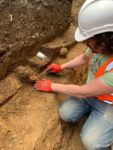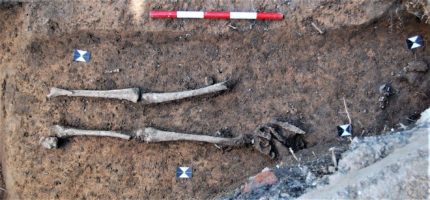The remains of an elite Anglo-Saxon woman adorned with fine jewelry have been unearthed on the Canterbury Christ Church University campus.
The woman, believed to have been in her twenties, was found buried with a silver, garnet-inlaid, Kentish disc brooch. Scientific testing on similar finds has shown the garnets are likely to have come from Sri Lanka rather than a nearer source. Such brooches, crafted in east Kent from exotic materials, were produced at the behest of the Kentish royal dynasty and distributed as gifts to those in their favour.
She was also wearing a necklace of amber and glass beads, a belt fastened with a copper alloy buckle, a copper alloy bracelet and was equipped with an iron knife. Together, the items found in the grave suggest that this young woman was buried between AD 580-600. She would have been a contemporary, and likely acquaintance, of the Kentish King Ethelbert and his Frankish Queen Bertha, whose modern statues can be seen nearby at Lady Wootton’s Green.
Archaeologists from the Canterbury Archaeological Trust (CAT) excavated the site of the former Canterbury Prison in advance of the construction of new Science, Technology, Health, Engineering and Medical facilities at  Canterbury Christ Church University. Between July 2018 and June 2019, the team unearthed a Romano-British cremation burial from the 2nd-3rd century, medieval trash pit full of animal bones, evidence of extensive post-medieval quarrying and a boundary ditch from the perimeter of St. Augustine’s Abbey, now a ruin after having been plundered for building material after the Dissolution of the Monasteries.
Canterbury Christ Church University. Between July 2018 and June 2019, the team unearthed a Romano-British cremation burial from the 2nd-3rd century, medieval trash pit full of animal bones, evidence of extensive post-medieval quarrying and a boundary ditch from the perimeter of St. Augustine’s Abbey, now a ruin after having been plundered for building material after the Dissolution of the Monasteries.
The Abbey was immensely important in its day. Founded in 598 by Augustine, the very first Archbishop of Canterbury who was sent by Pope Gregory the Great to Christianize the Anglo-Saxons, the monastery and its church were built on the grounds of the pagan temple at which Æthelberht, King of Kent, worshiped, or rather had worshiped before Augustine (doubtless heavily aided by Æthelberht’s Christian queen consort Bertha) converted him. The king commissioned construction of a church on the Abbey grounds dedicated to Saints Peter and Paul which was completed in 613. Archbishops of Canterbury and kings and queens of Kent would be buried within its masonry walls.
The newly-discovered grave almost certainly pre-dates the construction of Sts Peter and Paul Church and of the Abbey. We know the site was used as a burial ground in Roman times and held religious significance for pre-Christian Anglo-Saxons. This is now evidence that high-status Anglo-Saxons were buried there as well and that the Kentish royal family was continuing an established practice even after their conversion to Christianity. They just added the church.
Very little of her skeleton was recovered because soil conditions in the area are hard on bones, but there are a few surviving teeth which opens up the possibility of archaeological DNA and stable isotope analysis. Researchers hope to discover more about her life and death from further studies of her remains.

Ðæt mǽgdencild on Cantawarabyrgh – In contrast to ‘Brexit’, the hot topic back then was ‘Brentry’, and in a letter to the Franks Theuderic and Theudebert concerning St. Augustine’s mission to Kent in 597, Pope Gregory I says that he believed “that you wish your subjects in every respect to be converted to that faith in which you, their kings and lords, stand”. Liudhard, Bertha’s chaplain, was intended as a representative of the Frankish church in Kent. Moreover, there was a luxury trade between Kent and the Franks. Unfortunately, that islands Gospel is currently about to be changed, that is, fun’de’mentally:
————
“Interea Augustinus adiutorio usus Aedilbercti regis conuocauit ad suum colloquium episcopos siue doctores proximae Brettonum prouinciae in loco, qui usque hodie lingua Anglorum Augustinaes Ãc, id est robur Augustini, in confinio Huicciorum et Occidentalium Saxonum appellatur; coepitque eis fraterna admonitione suadere, ut pace catholica secum habita communem euangelizandi gentibus pro Domino laborem susciperent….”
“In the meantime, Augustine, with the assistance of King Æthelberht, drew together to a conference the bishops, or doctors, of the next province of the Britons, at a place which is to this day called Augustine’s Ac, i.e. Augustine’s Oak, on the borders of the Wiccii and West Saxons; and began by brotherly admonitions to persuade them, that preserving Catholic unity with him, they should undertake the common labour of preaching the Gospel to the Gentiles…”
————
Notably, Irmenric of Kent, apparently, had been a Saxon father of Æthelberht, while Bertha was obviously Clovis’ I Frankish great-granddaughter. As Richard I much later put it, in Occitan, “miei hom e miei baron, angles, norman, peitavin e gascon”.
Ah, it is nice to hear some news from home!
:chicken: :chicken: :chicken: :chicken: :chicken: :chicken: :chicken: :chicken: :chicken: :chicken: :chicken: :chicken: :chicken: :chicken: :chicken: :chicken: :chicken: :chicken: :chicken: :chicken: :chicken: :chicken: :chicken: :chicken: :chicken: :chicken: :chicken: :chicken: :chicken: :chicken: :chicken: :chicken: :chicken: :chicken: :chicken: :chicken: :chicken: :chicken: